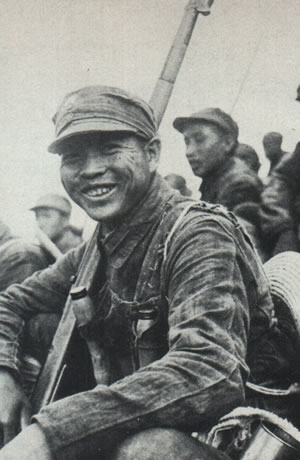Notes from The Challenge of Red China
by
Gunther Stein
For The U.S. War Against Asia
by William P. Meyers
Also sponsored by Peace Pins
Popular pages:
| U.S. War Against Asia |
| Fascism |
| Barack Obama |
| Democratic Party |
| Republican Party |
| Natural Liberation |
Page 2 of 5
 The Eighth Route Army claimed almost 600,000 soldiers in the spring of 1945. “The Great Three Tasks of the Army are to fight the enemy; to help the people in raising production; and to mobilize, organize, and educate the masses of the people for war and social progress.” [p. 99]
The Eighth Route Army claimed almost 600,000 soldiers in the spring of 1945. “The Great Three Tasks of the Army are to fight the enemy; to help the people in raising production; and to mobilize, organize, and educate the masses of the people for war and social progress.” [p. 99]
Communist lead militias claimed 2.2 million members [p. 102]
“New Democracy is the programmatic name of the permanent political system introduced by the Communists in 1940, and the title of one of the most read books of the party leader, Mao Tse-tung.” [p. 102]
“Voters cannot elect Communists to any more than one-third of the seats in any People’s political Council; … and at least one-third goes to nonparty candidates.” [p. 103-104]
He had extensive interviews with Mao, who expounded on the New Democracy. Mao summed up: “China’s needs at present are three: (1) to drive the Japanese out; (2) to realize democracy on a nationwide scale by giving the people all the forms of modern liberty and … governments elected by them in genuinely free and general elections …; and (3) to solve the agrarian question, so that capitalism of a progressive character can develop in China.” [p. 109]
He describes local self-government, in which there seems to be a great deal of broad based participation in discussions. [p. 121-130]. “The people were mobilized against only two enemies—the Japanese invaders and their own age-old political and social backwardness. Simple, practical slogans were propagated all over the country by primitive but often ingenious mass movements. Raise production. Foster cooperatives. Aim at the goal of being well fed and well clad. Support the army. Improve your standards of health. Discard superstition and acquire knowledge. Learn to read and write. Help the backward people in your community.” [p. 130]
He describes how army and government personnel have been required to contribute to production, for instance raising crops (usually involving improving land not previously tilled) and producing the simple consumer goods that could not be imported (spinning yarn, making clothing, etc.) [p. 133-142]
The Chinese version of Marxism was very pragmatic. It was simply “the materialistic approach to all social phenomena,” and was not dogmatic. [p. 143]
Chinese Nationalism was a stronger element than Marxism [p. 144]
He attributes the Communists’ independence from Moscow to its support of Chiang before the Communist-nationalist split in 1927, followed by the isolation of the communists. [p. 145]
